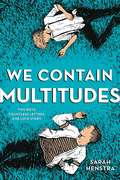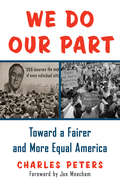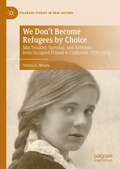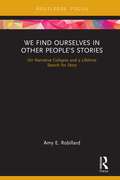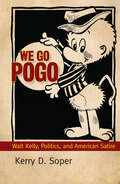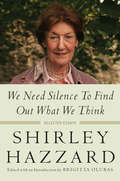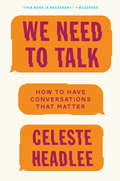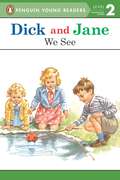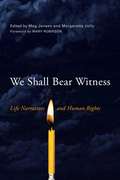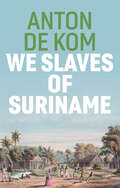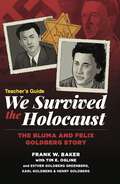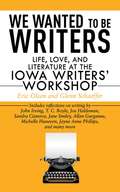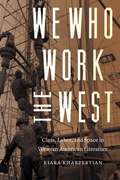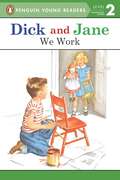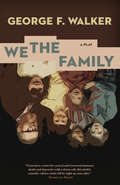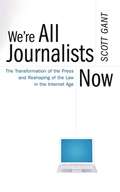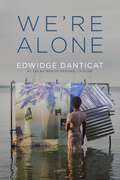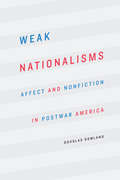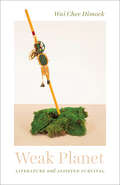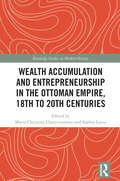- Table View
- List View
We Contain Multitudes
by Sarah HenstraAristotle and Dante Discover the Secrets of the Universe meets I'll Give You the Sun in an exhilarating and emotional novel about the growing relationship between two teenage boys, told through the letters they write to one another. Jonathan Hopkirk and Adam "Kurl" Kurlansky are partnered in English class, writing letters to one another in a weekly pen pal assignment. With each letter, the two begin to develop a friendship that eventually grows into love. But with homophobia, bullying, and devastating family secrets, Jonathan and Kurl struggle to overcome their conflicts and hold onto their relationship...and each other.This rare and special novel celebrates love and life with engaging characters and stunning language, making it perfect for fans of Jandy Nelson, Nina LaCour, and David Levithan.
We Do Our Part: Toward a Fairer and More Equal America
by Jon Meacham Charles PetersThe legendary editor who founded the Washington Monthly and pioneered explanatory journalism trains his keen, principled eye on the changes that have reshaped American politics and civic life beginning with the New Deal. “We Do Our Part” was the slogan of Franklin Delano Roosevelt’s National Recovery Administration—and it captured the can-do spirit that allowed America to survive the Great Depression and win World War II. Although the intervening decades have seen their share of progress as well, in some ways we have regressed as a nation. Over the course of a sixty-year career as a Washington, D.C., journalist, historian, and challenger of conventional wisdom, Charles Peters has witnessed these drastic changes firsthand. This stirring book explains how we can consolidate the gains we have made while recapturing the generous spirit we have lost. In a volume spanning the decades, Peters compares the flood of talented, original thinkers who flowed into the nation’s capital to join FDR’s administration with the tide of self-serving government staffers who left to exploit their opportunities on Wall Street and as lobbyists from the 1970s to today. During the same period, the economic divide between rich and poor grew, as we shifted from a culture of generosity to one of personal aggrandizement. With the wisdom of a prophet, Peters connects these two trends by showing how this money-fueled elitism has diminished our trust in one another and our nation—and changed Washington for the worse. While Peters condemns the crass buckraking that afflicts our capital, and the rampant consumerism that fuels our greed, he refuses to see America’s downward drift as permanent. By reminding us of our vanished civic ideal, We Do Our Part also points the way forward. Peter argues that if we want to revive the ethos of the New Deal era—a time when government attracted the brightest and the most dedicated, and when our laws reflected a spirit of humility and community—we need only demand it of ourselves and our elected officials. With a new administration in Washington, the time is ripe for a reassessment of our national priorities. We Do Our Part offers a vital road map of where we have been and where we are going, drawn from the invaluable perspective of a man who has seen America’s better days and still believes in the promise that lies ahead.
We Don't Become Refugees by Choice: Mia Truskier, Survival, and Activism from Occupied Poland to California, 1920-2014 (Palgrave Studies in Oral History)
by Teresa A. MeadeThis book traces the life of Maria Mia Truskier, who fled the Nazis as a young Polish Jew in early 1940 and once safely resettled in the United States, became an activist for other refugees, earning renown in the Bay Area as “the oldest refugee” of the East Bay Sanctuary Covenant. Mia worked for decades assisting those fleeing from war, violence and hardship, mainly from Central America and Haiti. Based on extensive interviews with Truskier before she passed away, as well as memorabilia from her own lifetime, including coded letters, newspaper clippings, and old photographs, this book results in a complex and multi-layered oral history. As Mia drew on memories of her life in Europe and World War II, she was situating and constructing those memories while re-reading and discovering these artifacts alongside the author of this book, and ultimately relating the ways that she and her family years later sought to make a difference for other refugees, drawing a connection between two major eras of human displacement: the end of World War II and today.
We Find Ourselves in Other People’s Stories: On Narrative Collapse and a Lifetime Search for Story
by Amy E. RobillardWe Find Ourselves in Other People’s Stories: On Narrative Collapse and a Lifetime Search for Story is a collection of five essays that dissolves the boundary between personal writing and academic writing, a longstanding binary construct in the discipline of composition and writing studies, in order to examine the rhetorical effects of narrative collapse on the stories we tell about ourselves and others. Taken together, the essays theorize the relationships between language and violence, between narrative and dementia, between genre and certainty, and between writing and life.
We Go Pogo: Walt Kelly, Politics, and American Satire (Tom Inge Series on Comics Artists)
by Kerry D. SoperWalt Kelly (1913–1973) is one of the most respected and innovative American cartoonists of the twentieth century. His long-running Pogo newspaper strip has been cited by modern comics artists and scholars as one of the best ever. Cartoonists Bill Watterson (Calvin and Hobbes), Jeff Smith (Bone), and Frank Cho (Liberty Meadows) have all cited Kelly as a major influence on their work. Alongside Uncle Scrooge's Carl Barks and Krazy Kat's George Herriman, Kelly is recognized as a genius of “funny animal” comics. We Go Pogo is the first comprehensive study of Kelly's cartoon art and his larger career in the comics business. Author Kerry D. Soper examines all aspects of Kelly's career—from his high school drawings; his work on such animated Disney movies as Dumbo, Pinocchio, and Fantasia; and his 1930s editorial cartoons for Life and the New York Herald Tribune. Soper taps Kelly's extensive personal and professional correspondence and interviews with family members, friends, and cartoonists to create a complex portrait of one of the art form's true geniuses. From Pogo's inception in 1948 until Kelly's death, the artist combined remarkable draftsmanship, slapstick humor, fierce social satire, and inventive dialogue and dialects. He used the adventures of his animals—all denizens of the Okefenokee Swamp—as a means to comment on American and international politics and cultural mores. The strip lampooned Senator Joseph McCarthy during the height of McCarthyism, the John Birch Society during the 1960s, Fidel Castro during the Bay of Pigs fiasco, and many others.
We Need Silence to Find Out What We Think: Selected Essays
by Shirley Hazzard Brigitta OlubasThese nonfiction works span from the 1960s to the 2000s and were produced by one of the great fiction writers of the period. They add critical depth to Shirley Hazzard's creative world and encapsulate her extensive and informed thinking on global politics, international relations, the history and fraught present of Western literary culture, and postwar life in Europe and Asia. They also offer greater access to her brilliant craftsmanship and the multiple registers in which her writings operate. Hazzard writes about the manifold failings of the United Nations, where she worked in the early 1950s. She shares her personal experience with the aftermath of the Hiroshima bombings and the nature of life in late-1940s Hong Kong. She presents her thoughts on the decline of the hero as a public figure in Western literature. These works contribute to a keener understanding of postwar letters, thought, and politics, supported by an introduction that situates Hazzard's writing within its historical context and emphasizes her influence on world literature. This collection confirms Hazzard's place within a network of writers, artists, and intellectuals who believe in the ongoing power of literature to console, inspire, and direct human life, despite-or maybe because of-the world's disheartening realities.
We Need Silence to Find Out What We Think: Selected Essays
by Shirley HazzardSpanning the 1960s to the 2000s, these nonfiction writings showcase Shirley Hazzard's extensive thinking on global politics, international relations, the history and fraught present of Western literary culture, and postwar life in Europe and Asia. They add essential clarity to the themes that dominate her award-winning fiction and expand the intellectual registers in which her writings work.Hazzard writes about her employment at the United Nations and the institution's manifold failings. She shares her personal experience with the aftermath of the Hiroshima atomic bombing and the nature of life in late-1940s Hong Kong. She speaks to the decline of the hero as a public figure in Western literature and affirms the ongoing power of fiction to console, inspire, and direct human life, despite—or maybe because of—the world's disheartening realities. Cementing Hazzard's place as one of the twentieth century's sharpest and most versatile thinkers, this collection also encapsulates for readers the critical events defining postwar letters, thought, and politics.
We Need to Talk: How to Have Conversations That Matter
by Celeste Headlee“WE NEED TO TALK.”In this urgent and insightful book, public radio journalist Celeste Headlee shows us how to bridge what divides us--by having real conversationsBASED ON THE TED TALK WITH OVER 10 MILLION VIEWS“We Need to Talk is an important read for a conversationally-challenged, disconnected age. Headlee is a talented, honest storyteller, and her advice has helped me become a better spouse, friend, and mother.” (Jessica Lahey, author of New York Times bestseller The Gift of Failure)Today most of us communicate from behind electronic screens, and studies show that Americans feel less connected and more divided than ever before. The blame for some of this disconnect can be attributed to our political landscape, but the erosion of our conversational skills as a society lies with us as individuals. And the only way forward, says Headlee, is to start talking to each other. In We Need to Talk, she outlines the strategies that have made her a better conversationalist—and offers simple tools that can improve anyone’s communication. For example: BE THERE OR GO ELSEWHERE. Human beings are incapable of multitasking, and this is especially true of tasks that involve language. Think you can type up a few emails while on a business call, or hold a conversation with your child while texting your spouse? Think again.CHECK YOUR BIAS. The belief that your intelligence protects you from erroneous assumptions can end up making you more vulnerable to them. We all have blind spots that affect the way we view others. Check your bias before you judge someone else.HIDE YOUR PHONE. Don’t just put down your phone, put it away. New research suggests that the mere presence of a cell phone can negatively impact the quality of a conversation. Whether you’re struggling to communicate with your kid’s teacher at school, an employee at work, or the people you love the most—Headlee offers smart strategies that can help us all have conversations that matter.
We See (Dick and Jane #Vol. 9)
by Penguin Young ReadersLook, Spot. Look, Puff. Look and see. See Sally and Tim.
We Shall Bear Witness
by Margaretta Jolly Meg JensenPersonal testimonies are the life force of human rights work, and rights claims have brought profound power to the practice of life writing. This volume explores the connections and conversations between human rights and life writing through a dazzling, international collection of essays by survivor-writers, scholars, and human rights advocates. In"We Shall Bear Witness," editors Meg Jensen and Margaretta Jolly assemble moving personal accounts from those who have endured persecution, imprisonment, and torture; meditations on experiences of injustice and protest by creative writers and filmmakers; and innovative research on ways that digital media, commodification, and geopolitics are shaping what is possible to hear and say. The book's primary sections-testimony, recognition, representation, and justice-evoke the key stages in turning experience into a human rights life story and attend to such diverse and varied arts as autobiography, documentary film, report, oral history, blog, and verbatim theater. The result is a groundbreaking book that sensitively examines how life and rights narratives have become so powerfully entwined. Also included is an innovative guide to teaching human rights and life narrative in the classroom. "
We Share Our Matters: Two Centuries of Writing and Resistance at Six Nations of the Grand River
by Rick MontureThe Haudenosaunee, more commonly known as the Iroquois or Six Nations, have been one of the most widely written-about Indigenous groups in the United States and Canada. But seldom have the voices emerging from this community been drawn on in order to understand its enduring intellectual traditions. Rick Monture’s We Share Our Matters offers the first comprehensive portrait of how the Haudenosaunee of the Grand River region have expressed their long struggle for sovereignty in Canada. Drawing from individualsas diverse as Joseph Brant, Pauline Johnson and Robbie Robertson, Monture illuminates a unique Haudenosaunee world view comprised of three distinct features: a spiritual belief about their role and responsibility to the earth; a firm understanding of their sovereign status as a confederacy of independant nations; and their responsibility to maintain those relations for future generations. After more than two centuries of political struggle Haudenosaunee thought has avoided stagnant conservatism and continues to inspire ways to address current social and political realities.
We Slaves of Suriname
by Anton de KomAnton de Kom’s We Slaves of Suriname is a literary masterpiece as well as a fierce indictment of racism and colonialism. In this classic book, published here in English for the first time, the Surinamese writer and resistance leader recounts the history of his homeland, from the first settlements by Europeans in search of gold through the era of the slave trade and the period of Dutch colonial rule, when the old slave mentality persisted, long after slavery had been formally abolished. 159 years after the abolition of slavery in Suriname and 88 years after its initial publication, We Slaves of Suriname has lost none of its brilliance and power.
We Survived the Holocaust Teacher's Guide: The Bluma and Felix Goldberg Story
by Frank W. Bakererasing an entire populationBluma TishgartenFelix Goldberga dangerous history that, if we do not heed the warning signs, could very well be repeated.
We Wanted to Be Writers: Life, Love, and Literature at the Iowa Writers' Workshop
by Glenn Schaeffer Bill Manhire Eric OlsenWe Wanted to be Writers is a rollicking and insightful blend of original interviews, commentary, advice, gossip, anecdotes, analyses, history, and asides with nearly thirty graduates and teachers at the now legendary Iowa Writers' Workshop between 1974 and 1978. Among the talents that emerged in those years-writing, criticizing, drinking, and debating in the classrooms and barrooms of Iowa City-were the younger versions of writers who became John Irving, Jane Smiley, T. C. Boyle, Michelle Huneven, Allan Gurganus, Sandra Cisneros, Jayne Anne Phillips, Jennie Fields, Joy Harjo, Joe Haldeman, and many others. It is chock full of insights and a treasure trove of inspiration for all writers, readers, history lovers, and anyone who ever wanted to be a writer. Jane Smiley on the Iowa writers' workshop: In that period, the teachers tended to be men of a certain age, with the idea that competition was somehow the key-the Norman Mailer period. The story was that if you disagreed with Norman, or gave him a bad review, he'd punch you in the nose. You were supposed to get in fights in restaurants. T. C. Boyle on his short story Drowning: I got $25 for it, which was wonderful . . . You know, getting $25 for the product of your own brain? You could buy a lot of beer in Iowa City back then for that.
We Who Work the West: Class, Labor, and Space in Western American Literature (Postwestern Horizons)
by Kiara KharpertianWe Who Work the West examines literary representations of class, labor, and space in the American West from 1885 to 2012. Moving from María Amparo Ruiz de Burton&’s representations of dispossessed Californio ranchers in the mid-nineteenth century to the urban grid of early twentieth-century San Francisco in Frank Norris&’s McTeague to working and unemployed cowboys in the contemporary novels of Cormac McCarthy and Larry McMurtry, Kiara Kharpertian provides a panoramic look at literary renderings of both individual labor—physical, tangible, and often threatened handwork—and the epochal transformations of central institutions of a modernizing West: the farm, the ranchero, the mine, the rodeo, and the Native American reservation. The West that emerges here is both dynamic and diverse, its on-the-ground organization of work, social class, individual mobility, and collective belonging constantly mutating in direct response to historical change and the demands of the natural environment. The literary West thus becomes more than a locus of mythic nostalgia or consumer fantasy about the American past. It becomes a place where the real work of making that West, as well as the suffering and loss it often entailed, is reimagined.
We Work (Dick and Jane #Vol. 10)
by Penguin Young ReadersOh, Dick. Oh, Jane. See, see. Sally can work.
We the Family
by George F. WalkerWe the Family brings us three plays on family and education: Parents' Night documents a teacher's response to an overbearing father; The Bigger Issue examines teacher-student violence; We the Family follows the ripple effects of a culturally diverse wedding.George F. Walker is one of Canada's most prolific and popular playwrights.
We're All Journalists Now
by Scott GantAs the internet continues to reshape almost all corners of our world, no institution has been more profoundly altered than the practice of journalism and distribution of information. In this provocative new book, Scott Gant, a distinguished Washington attorney and constitutional law scholar, argues that we as a society need to rethink our notions of what journalism is, who is a journalist and exactly what the founding fathers intended when they referred to "the freedom of the press." Are bloggers journalists, even if they receive no income? Even if they are unedited and sometimes irresponsible? Many traditional news organizations would say no. But Gant contends otherwise and suggests we think of these sometimes unruly online purveyors of information and opinion as heirs to those early pamphleteers who helped shape our fledgling democracy. He gives us a persuasive and engaging argument for affording bloggers and everyone else who disseminates information and opinion in the U.S. the same rights and privileges that traditional journalists enjoy. The rise of the Internet and blogosphere has blurred the once distinct role of the media in our society. It wasn't long ago that the line between journalists and the rest of us seemed relatively clear: Those who worked for news organizations were journalists and everyone else was not. Those days are gone. On the Internet, the line has totally disappeared. It's harder than ever to answer the question, "Who is a journalist?" Yet it is a question asked routinely in American courtrooms and legislatures because there are many circumstances where those deemed "journalists" are afforded rights and privileges not available to the rest of us. The question will become increasingly important as the transformation of journalism continues, and bloggers and other "citizen journalists" battle for equal standing with professional journalists. Advancing arguments that are sure to stir controversy, Scott Gant leads the debate with a serious yet accessible discussion about whether, where, and how the government can decide who is a journalist. Challenging the mainstream media, Gant puts forth specific arguments about how to change existing laws and makes elegant suggestions for new laws that will properly account for the undeniable reality that We're All Journalists Now. For all of us who care about the ways in which the digital revolution is sweeping through our culture, this is a work of opinion that will be seen as required reading.
We're Alone: Essays
by Edwidge DanticatA collection of exceptional new essays by one of the most significant contemporary writers on the world stage Tracing a loose arc from Edwidge Danticat’s childhood to the COVID-19 pandemic and recent events in Haiti, the essays gathered in We’re Alone include personal narrative, reportage, and tributes to mentors and heroes such as Toni Morrison, Paule Marshall, Gabriel García Márquez, and James Baldwin that explore several abiding themes: environmental catastrophe, the traumas of colonialism, motherhood, and the complexities of resilience.From hurricanes to political violence, from her days as a new student at a Brooklyn elementary school knowing little English to her account of a shooting hoax at a Miami mall, Danticat has an extraordinary ability to move from the personal to the global and back again. Throughout, literature and art prove to be her reliable companions and guides in both tragedies and triumphs.Danticat is an irresistible presence on the page: full of heart, outrage, humor, clear thinking, and moral questioning, while reminding us of the possibilities of community. And so “we’re alone” is both a fearsome admission and an intimate invitation—we’re alone now, we can talk. We’re Alone is a book that asks us to think through some of the world’s intractable problems while deepening our understanding of one of the most significant novelists at work today.
We, Us, and Them: Affect and American Nonfiction from Vietnam to Trump (Cultural Frames, Framing Culture)
by Douglas DowlandWhen Americans describe their compatriots, who exactly are they talking about? This is the urgent question that Douglas Dowland asks in We, Us, and Them. In search of answers, he turns to narratives of American nationhood written since the Vietnam War—stories in which the ostensibly strong state of the Union has been turned increasingly into an America of us versus them. Dowland explores how a range of writers across the political spectrum, including Hunter S. Thompson, James Baldwin, and J. D. Vance, articulate a particular vision of America with such strong conviction that they undermine the unity of the country they claim to extol. We, Us, and Them pinpoints instances in which criticism leads to cynicism, rage leads to apathy, and a broad vision narrows in our present moment.
Weak Nationalisms: Affect and Nonfiction in Postwar America
by Douglas DowlandThe question “What is America?” has taken on new urgency. Weak Nationalisms explores the emotional dynamics behind that question by examining how a range of authors have attempted to answer it through nonfiction since the Second World War, revealing the complex and dynamic ways in which affects shape the literary construction of everyday experience in the United States. Douglas Dowland studies these attempts to define the nation in an eclectic selection of texts from writers such as Simone de Beauvoir, John Steinbeck, Charles Kuralt, Jane Smiley, and Sarah Vowell. Each of these texts makes use of synecdoche, and Weak Nationalisms shows how this rhetorical technique is variously driven by affects including curiosity, discontent, hopefulness, and incredulity. In exploring the function of synecdoche in the creative construction of the United States, Dowland draws attention to the evocative politics and literary richness of nationalism and connects critical literary practices to broader discussions involving affect theory and cultural representation.
Weak Planet: Literature and Assisted Survival
by Wai Chee Dimock“Exploring weakness and vulnerability from the origins of American literature to the present, she provocatively argues for ‘collateral resilience.’” —Viet Thanh Nguyen, Pulitzer Prize–winning authorVulnerability. We see it everywhere. In once permanent institutions. In runaway pandemics. In democracy itself. And most frighteningly, in ecosystems with no sustainable future. Against these large-scale hazards of climate change, what can literature teach us? This is the question Wai Chee Dimock asks in Weak Planet, proposing a way forward, inspired by works that survive through kinship with strangers and with the nonhuman world.Drawing on Native American studies, disability studies, and environmental humanities, Dimock shows how hope can be found not in heroic statements but in incremental and unspectacular teamwork. Reversing the usual focus on hegemonic institutions, she highlights instead incomplete gestures given an afterlife with the help of others. She looks at Louise Erdrich’s and Sherman Alexie’s user-amended captivity narratives; nontragic sequels to Moby-Dick by C. L. R. James, Frank Stella, and Amitav Ghosh; induced forms of Irishness in Henry James, Colm Tóibín, W. B. Yeats, and Gish Jen; and the experimentations afforded by a blurry Islam in works by Henri Matisse, James Joyce, Ezra Pound, and Langston Hughes. Celebrating literature’s durability as an assisted outcome, Weak Planet gives us new ways to think about our collective future.“Weak Planet invites us to reflect on the deep interconnections between two threatened extinctions: that of the humanities and that of a host of animal species (not least our own). The book is nothing short of a radical reorientation of literary history.” —Stephen Best, author of None Like Us: Blackness, Belonging, Aesthetic Life
Wealth Accumulation and Entrepreneurship in the Ottoman Empire, 18th to 20th Centuries (Routledge Studies in Modern History)
by Maria Christina Chatziioannou Sophia LaiouThis book provides a significant contribution to our understanding of the Ottoman Empire’s economic history, particularly through its exploration of local entrepreneurship, which brings new perspectives to the economic dynamics of the region.This focus adds a valuable dimension to the broader narrative of Mediterranean social and economic developments from the 18th to the 20th century. By emphasizing the role of both Muslim and non-Muslim agents, the work challenges more Eurocentric narratives that have often influenced the historiography of economic activities in this region. The inclusion of Ottoman, Turkish, and Greek sources underlines the importance of accessing voices and records that have been underutilized in previous studies. The fact that this project is a result of Greek–Turkish academic cooperation is particularly noteworthy, as it promotes a more nuanced and comprehensive view toward shared histories in order to shed light on complex historical phenomena.This work will be of interest to scholars of Ottoman and Mediterranean history seeking to explore the nuances of economic and social change from within the Ottoman Empire. It will also appeal to a wider audience interested in the history of early entrepreneurial activities and the complex interplay between cultural and economic dynamics in historical contexts.
